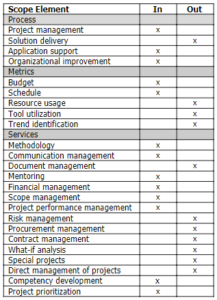You have just been selected to manage that big, important corporate project. You realize the project’s charter is nowhere to be found. How do you go about defining your project’s scope?
Your project has a footprint.
Your project’s scope defines the footprint of your project. Like the changing footprint of a human from baby to adult, your project’s footprint will change over the life of your project. Your project’s success is determined by how well you define, communicate, and elaborate that footprint.
A project’s scope defines any required work and only the work that is necessary for the successful completion of your project. It is the sum of deliverables, results, and services that will be produced by your project. Without a proper definition of the project’s result, you’ll be experimenting with project success.
Don’t skip or skimp!
Developing and maintaining a shared understanding of your project is foundational. Defining your project’s scope properly has many benefits that have a direct, positive correlation to project success:

Spend adequate time with your stakeholders and listen to how they describe the project’s result. Don’t rush the process! Capture what you hear in a way that clearly conveys what the project will deliver.
Is it a good scope statement?
Your project’s scope definition is complete when both the product and project scope elements are reflected and integrated. What is the difference? Product scope is measured against requirements and supported by the solution delivery process. Project scope is measured against the work plan and supported by the project management process.
Your project’s scope is well-defined when each stakeholder can see the elements that are important to them and when all stakeholders agree that the project’s scope is complete as well as accurate.
A project’s scope is not the same as the project’s requirements. Scope definition is part of a project management process at project initiation; The requirements definition is part of a solution delivery process addressed in project planning. Requirement definition has one of the biggest impacts on scope definition because the project’s scope and what the business requires must be in alignment.
Bring on the matrix!
I use a tabular approach to scope definition to help stakeholders understand what the project is, what the project might be in the future, and what the project is not. Defining scope in a tabular format allows scope elements to be categorized and bundled, which allows for a detailed review, deeper insights, and at-a-glance synthesis of a lot of information.
If the key deliverable is the setup of Project Management Office (PMO), here’s an abbreviated simple example of how the tabular approach could begin to define the scope of the project. For each scope element, the presence or absence of text in the columns indicates the scope status of that particular element. Descriptive wording can be provided instead of a generic “x” to ensure a shared understanding of complex elements.

Make the columns meaningful for your project. Project result delivered in phases? Add columns for each project phase. Stakeholders undecided about scope elements? Add a column called “Evolving.” Is the general sequencing of scope elements indicated? Add columns called “Next” and “Later” after “In.” Is the word “Out” too strong for your organization’s culture? Use “Excluded” instead.
The more your stakeholders can see project elements of interest to them in your scope statement, the easier it becomes to manage and control your project.
FAQs
Q: What is the project scope?
A: Project scope refers to the boundaries and limits of a project, defining what work will be included in the project and what will not. It includes the sum of deliverables, results, and services that will be produced by the project.
Q: Why is defining project scope important?
A: Defining project scope is crucial because it sets the foundation for the entire project. It helps ensure that all stakeholders understand what the project aims to achieve and what work will be required. Properly defining project scope is directly linked to project success.
Q: What is the difference between product scope and project scope?
A: Product scope refers to the features, functionality, and characteristics of the project’s end product or solution. On the other hand, project scope refers to the work plan and the tasks, activities, and resources required to complete the project successfully.
Q: How does scope relate to requirements?
A: Scope and requirements are closely related but not the same. Scope defines the project’s boundaries, while requirements define the end product or solution’s features, functionality, and characteristics. Requirement definition impacts scope definition, as the project’s scope and business requirements must be aligned.
Q: How can I define project scope effectively?
A: Here are some tips for effective project scope definition:
- Spend adequate time with stakeholders to understand their perspectives and capture their expectations.
- Use a tabular approach to categorize and bundle scope elements for easy review and synthesis.
- Make sure the scope statement reflects both product and project scope elements.
- Ensure that all stakeholders agree on the completeness and accuracy of the scope statement.
- Keep the scope statement updated and aligned with project progress and changes.
Q: Can the project scope change during the project?
A: Yes, the project scope can change during the project due to various factors such as new requirements, changes in business needs, and external influences. However, any changes to the project scope should be carefully managed and communicated to stakeholders to avoid scope creep and ensure project success. Overall, it’s essential to have a formal change management process to handle scope changes effectively.
Q: How does a well-defined project scope contribute to project success?
A: A well-defined project scope ensures that all stakeholders have a shared understanding of the project’s objectives, deliverables, and boundaries. This helps in effective project planning, resource allocation, and risk management. It also minimizes scope creep, which can cause budget and timeline overruns. A well-defined scope statement is a reference point throughout the project, allowing for better control, monitoring, and successful completion.

